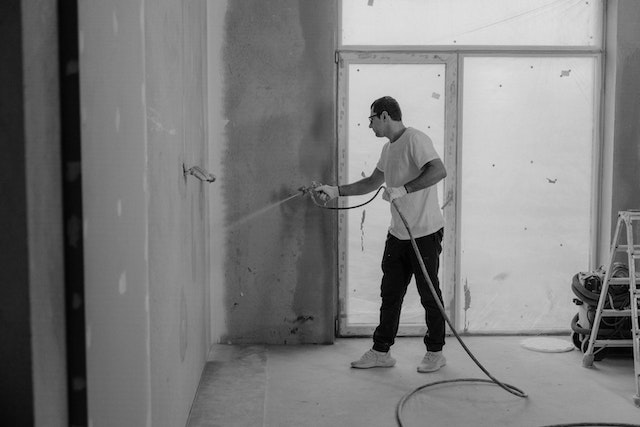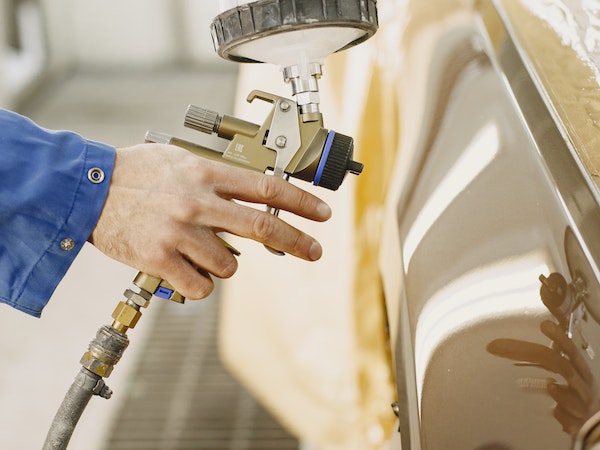After applying the final coat of latex paint on a model, you want to ensure the surface coating is well protected. Lacquer is one of the best clear coats to create a perfect protective finish on most paints.
But can you apply lacquer finish over latex paint? Yes, that’s possible, especially if the paint contains no sheen. Another exception is not to apply too much lacquer on the paint, which may cause wrinkling.
The bottom line is that spraying lacquer over latex is possible, but several factors must be considered. To avoid confusion, we will show you how to apply lacquer over latex and explain the factors and everything else you need to know.
Can You Spray Lacquer Over Latex Paint?
Yes, spraying lacquer over latex paint is possible. Just ensure no pollutants are on the surface by carefully preparing it for the paint. This will maximize adhesion. Also, ensure the latex paint doesn’t contain sheen, as it can be repelled by lacquer solvents, causing surface cracks. It’s much easier to apply lacquer over flat latex.
Can Lacquer Stick to Latex Paint?
Most painters who ask the question: can I spray lacquer over latex paint, often wonder if lacquer sealant can stick to latex paint. For them, adhesion is a great concern because, without it, your project will be ruined.
However, lacquer’s ability to stick to latex depends on various factors. For example, latex often contains fixative chemicals that give it a unique sheen.
These chemicals repel lacquer upon contact, resulting in wrinkles and bristles. But you wouldn’t experience the same problems with flat latex paints since they don’t contain these unique chemicals.
Other factors that may affect lacquer adhesion are the quality of latex paint, how well-prepared the surface is, and the type of lacquer coat applied.
Generally, most lacquer types will adhere to latex paint, especially if you apply thin coats. On the other hand, lacquer cannot stick properly on oil-based paints.
So if you’re thinking of applying lacquer over enamel latex or a similar oil-based paint, you’ll need to strip down the paint from the surface, prime it, apply latex paint, then a clear coat of lacquer over it.
What are the Different Types of Lacquer You Can Use Over Latex?
Lacquer comes in several different finishes. While some may have similar characteristics, others differ slightly. Below are the three different types of lacquer you can spray over latex paint.
1. Acrylic Lacquer
Developed in the 50s, acrylic lacquers are commonly used on wooden surfaces, especially softwoods like ash, birch, and maple.
This type of lacquer is made with synthetic acrylic polymers, which, once dry, produces a water-white finish instead of a yellowish shade common with other lacquers.
These finishes are also durable and not susceptible to scratches. If you’ve never used acrylic lacquers, CAB-Acrylic Lacquers is a good example.
This product is made of acrylic resins and cellulose acetate butyrate (CAB), which provide better flexibility and are less susceptible to cracking than traditional lacquer options.
2. Nitrocellulose Lacquer
Nitrocellulose lacquer was first manufactured in the 1920s as the primary clear coat for guitars, pianos, and similar musical instruments. It was also the most popular finish for automotive coating.
Today this lacquer option is the ideal choice for metal thanks to its smooth drying properties and high-gloss finish.
The only disadvantage of nitrocellulose lacquer is that after prolonged use, they tend to develop a reddish-amber tint which may be unsightly on some surfaces.
This yellowing makes nitrocellulose lacquer unsuitable for softwood surfaces. It’s also susceptible to cracking with an extended lifespan and is not resistant to abrasions and chemicals.
3. Pre-Catalyzed Lacquer
Lacquer typically dries as the solvents evaporate. However, some types contain solvents that affect the curing process.
Pre-catalyzed lacquer contains acid that provides maximum protection to the surface once the lacquer dries. The manufacturer usually adds these extra chemicals after production to enhance durability and reduce finishing issues.
What is the best way to spray lacquer over latex?
Adding lacquer coating is a great way to maintain a protective finish and glossy seal on any surface, especially if it was previously painted with latex.
But before undertaking such a project, ensure you have everything you need, especially safety equipment to protect yourself. Other tools required include a spray gun and a conducive workspace with proper ventilation.
Also, ensure the surface is well sanded, contains no dust, and, if possible, stained with a stain-blocking sealer to mitigate discoloration. Once you’ve set up everything, follow these steps:
Step 1: Prepare the lacquer mixture and ensure it can be sprayed easily with a spray gun, airless sprayer, or aerosol can.
Step 2: Shake the can consistently for a minute or two to mix the contents thoroughly. You can even add a lacquer paint thinner if necessary, according to the instructions from the manufacturer.
Step 3: After properly mixing the paint, add it to a sprayer with a suitable spray gun. Also, confirm if the pressure setting is properly adjusted to create a consistent spray pattern.
Step 4: Start spraying on the latex-painted surface, ensuring you move the gun consistently and overlapping when necessary.
Step 5: Apply at least three coats of lacquer, and with each coat, pause for 10 minutes for the finish to dry before adding the next coat. Keep the coats light or thin, then leave the surface to dry.
Should you sand before applying lacquer over latex paint?
Yes, sanding is recommended before applying lacquer. It helps smoothen the surface and removes any paint bumps and particles that may compromise adhesion or the final finish.
In this case, 150- to 220 fine-grit sandpaper would be ideal. Start with the coarsest part before transitioning to the finer grit while sanding in multiple rounds.
Once you’re done, remove the dust generated by sanding and wipe with a damp rag before applying the first coat of lacquer.
How Soon Can You Spray Lacquer After Painting Latex?
The time you should wait to spray lacquer after painting latex depends on your product type or brand.
For example, Rust-Oleum and Krylon spray paint and lacquer products have specific waiting times that differ from other brands.
However, the ideal waiting time should be 24 hours before applying a clear coat. Also, ensure there’s no humidity, and the temperature levels are favorable enough to shorten this time.
Ensure the latex is completely dry before you can add a clear coat. Also, ensure the paint and lacquer coats are thin enough to support quick drying.
Note that 24 hours is the minimum drying time but for best results, let your latex-painted surface dry and cure for 3-4 days before sealing with lacquer.

How Long Should You Wait Between Coats of Lacquer?
Wait for the paint to dry for 24 hours, then apply lacquer. This time is enough for the paint to cure and be ready to accept lacquer.
After that, you can apply thin coats of the clear coat, letting each coat dry for a few hours before adding the next layer.
Depending on your sealant, 3-5 light coats of lacquer should be enough. For best results, consider sanding between coats of lacquer with fine-grit sandpaper, then, after lacquer application, polish and wax accordingly.
How Do You Protect Lacquer Finish?
Lacquer offers a durable finish, color options, and better aesthetics to painted surfaces. It’s also suitable for use in high-traffic areas where it protects against the heavy effects of traffic use.
Therefore proper maintenance is necessary to retain the beautiful high gloss finish of lacquer coating. Below are a few practical ways to protect lacquer finish on any surface.
- Always ensure the lacquer surface is dry. Wipe away any accidental spills immediately to prevent damage.
- Wipe the surface with a clean rag to keep your lacquer finish free from dirt.
- Avoid using cleaning agents that contain bleach ammonia. Instead, use mild soap or regular detergent to clean the surface.
Pro Tips for Spraying Lacquer Over Latex Paint
If you want success after applying lacquer paint over latex, check out some of our pro tips for the best paint job.
- Thin the latex paint with lacquer thinner or 10% water and spray flat latex over the surface before spraying latex.
- If you must apply lacquer over latex containing sheen, ensure the surface is entirely primed, especially with shellac-based primers.
- Always use a waterborne lacquer finish with the correct primer.
- Read the label on the product to ascertain if you got the recommended products.
- Avoid spraying lots of lacquer in a single coat as too thick layers can cause wrinkles and blisters and may develop adhesion issues. Instead, apply multiple coats but keep them thin.
- When spraying lacquer over latex, allow each coat to sit for three hours before adding another.
FAQS: Can You Paint Latex Over Lacquer?
Can I spray lacquer over water-based paint?
Yes. Lacquer is versatile and sticks on various types of spray paint, especially on wood surfaces. You can spray it on oil-based paints and water-based paint like latex. However, certain latex paints containing sheen are incompatible with lacquer as they react badly upon contact. For such paint, you’ll need to strip the paint, prime, apply a new coat of latex paint then finish off with lacquer.
Can you spray a clear coat over latex paint?
Yes. Different types of clear coats, such as lacquer and varnish, can be used to seal latex paint. Other options include polyurethane which helps protect latex-painted surfaces from chipping, cracking, and peeling. Spraying a coat on the surface also gives it a lustrous feel, improves its overall aesthetics, and makes it easier to maintain.
Can you put lacquer over water-based paint?
Yes, but not right away after application of paint. It would be best if you let the water-based paint undergo a natural chemical transformation before you can apply any solvents to it. Therefore ensure the paint dries and cures sufficiently. The paint shouldn’t just dry to the touch for a few minutes or hours but should be left to sit for at least 24 hours or even overnight before applying lacquer. This time is enough for the paint to retain strength, harden, and support adhesion.
How long does the paint need to dry before lacquer?
Depending on the type of paint, the time it would take for it to dry to touch should be a few minutes to a few hours. However, it’s best to let the paint dry for 3-4 hours and cure for one to four days before sealing with a clear lacquer coat. Always remember that humidity and temperature range largely influence how fast your paint will dry before you lacquer.
Conclusion: Spraying Lacquer Over Latex Paint
Now you know you can spray lacquer over latex paint. However, as we’ve shown, this is only possible with flat latex paint that contains no sheen.
If you must lacquer oil paint over latex with sheen, adequately prepare the surface to ensure maximum adhesion and best results.
The three types of lacquer you can spray over latex include acrylic lacquer, nitrocellulose lacquer, and pre-catalyzed lacquer. Follow the steps in this guide on properly applying clear coat finishes on latex paint for a smooth and glossy finish.

